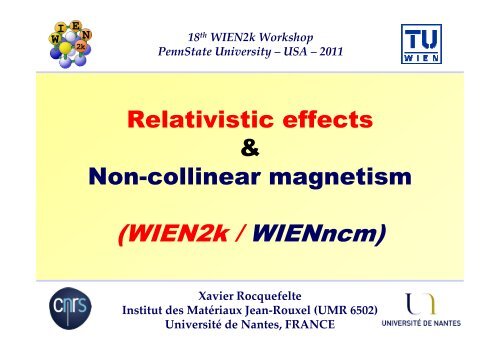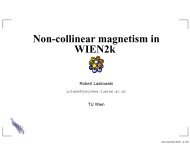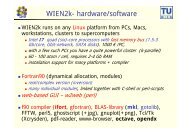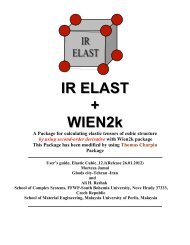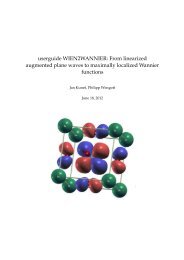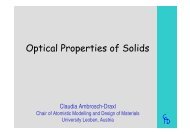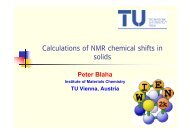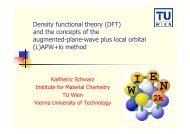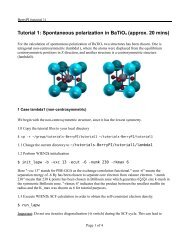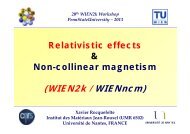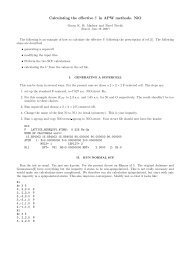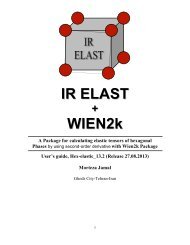Create successful ePaper yourself
Turn your PDF publications into a flip-book with our unique Google optimized e-Paper software.
18 th <strong>WIEN</strong><strong>2k</strong> WorkshopPennState University – USA – 2011Relativistic effects&Non-collinear magnetism(<strong>WIEN</strong><strong>2k</strong> / <strong>WIEN</strong>ncm)Xavier RocquefelteInstitut des Matériaux Jean-Rouxel (UMR 6502)Université de Nantes, FRANCE
18 th <strong>WIEN</strong><strong>2k</strong> WorkshopPennState University – USA – 2011Talk constructed using the following documents:Slides of:Robert Laskowski, Stefaan Cottenier, Peter Blaha and Georg MadsenNotes of:- Pavel Novak (Calculation of spin-orbit coupling)http://www.wien<strong>2k</strong>.at/reg_user/textbooks/- Robert Laskowski (Non-collinear magnetic version of <strong>WIEN</strong><strong>2k</strong> package)Books:- <strong>WIEN</strong><strong>2k</strong> userguide, ISBN 3-9501031-1-2- Electronic Structure: Basic Theory and Practical Methods, Richard M. Martin– ISBN 0 521 78285 6- Relativistic Electronic Structure Theory. Part 1. Fundamentals, PeterSchewerdtfeger, ISBN 0 444 51249 7web:- http://www2.slac.stanford.edu/vvc/theory/relativity.html- wienlist digest - http://www.wien<strong>2k</strong>.at/reg_user/index.html- wikipedia …
Few words about Special Theory of RelativityLightComposed of photons (no mass)Speed of light = constantAtomic units:ħ = m e = e = 1c ≈ 137 au
Few words about Special Theory of RelativityLightComposed of photons (no mass)Speed of light = constantMatterComposed of atoms (mass)v = f(mass)Atomic units:ħ = m e = e = 1Speed ofmattermassc ≈ 137 aumass = f(v)
Few words about Special Theory of RelativityLightComposed of photons (no mass)Speed of light = constantMatterComposed of atoms (mass)v = f(mass)Atomic units:ħ = m e = e = 1Speed ofmattermassc ≈ 137 aumass = f(v)Lorentz Factor (measure of the relativistic effects)γ =1−1⎛⎜⎝vc⎞⎟⎠2≥ 1Relativistic mass: M = γm (m: rest mass)Momentum: p = γmv = MvTotal energy: E 2 = p 2 c 2 + m 2 c 4E = γmc 2 = Mc 2
Definition of a relativistic particle (Bohr model)10987654321Lorentz factor (γ)« Non-relativistic »particle: γ = 1H(1s)Au(1s)0 20 40 60 80 100 120Speed (v)Details for Au atom:79v e( 1s)= c = 0. 58c137c ≈ 137 auγ =1−1⎛⎜⎝v ecSpeed of the 1s electron (Bohr model):Zv e∝n2⎞⎟⎠=1−e -1( 0.58)2+ZeH ::vv e (1s)1au γ = 00003e (1s) = 1au γ =1. 00003Au : vAu : ve (1s) = 79 au γe (1s) ==1.2279 au γ =1.22= 1.221s electron of Au atom = relativistic particleM e (1s-Au) = 1.22m e
Relativistic effects+Ze1) The mass-velocity correctionRelativistic increase in the mass of an electron with its velocity (when v e → c)
Relativistic effects+Ze1) The mass-velocity correctionRelativistic increase in the mass of an electron with its velocity (when v e → c)2) The Darwin termIt has no classical relativistic analogueDue to small and irregular motions of an electron about its mean position (Zitterbewegung)
Relativistic effects+Ze1) The mass-velocity correctionRelativistic increase in the mass of an electron with its velocity (when v e → c)2) The Darwin termIt has no classical relativistic analogueDue to small and irregular motions of an electron about its mean position (Zitterbewegung)3) The spin-orbit couplingIt is the interaction of the spin magnetic moment (s) of an electron with the magnetic fieldinduced by its own orbital motion (l)
Relativistic effects+Z eff e1) The mass-velocity correctionRelativistic increase in the mass of an electron with its velocity (when v e → c)2) The Darwin termIt has no classical relativistic analogueDue to small and irregular motions of an electron about its mean position (Zitterbewegung)3) The spin-orbit couplingIt is the interaction of the spin magnetic moment (s) of an electron with the magnetic fieldinduced by its own orbital motion (l)4) Indirect relativistic effectThe change of the electrostatic potential induced by relativity is an indirect effect of thecore electrons on the valence electrons
One electron radial Schrödinger equationHARTREE ATOMIC UNITSINTERNATIONAL UNITS⎡ 1 2H SΨ = ⎢−∇⎣ 2⎤+ V ⎥ Ψ = εΨ⎦HSΨ=⎡⎢−⎣2h2me∇2⎤+ V ⎥ Ψ = εΨ⎦Atomic units:ħ = m e = e = 11/(4 πε 0 ) = 1c = 1/ α ≈ 137 au
One electron radial Schrödinger equationHARTREE ATOMIC UNITSINTERNATIONAL UNITS⎡ 1 2H SΨ = ⎢−∇⎣ 2V= −⎤+ V ⎥ Ψ = εΨ⎦ZrHIn a sphericallysymmetric potentialΨ= RSΨ( r) Y ( θ,ϕ)n, l,m n,l l,m=⎡⎢−⎣V2h2me∇22Ze= −4πε r⎤+ V ⎥ Ψ = εΨ⎦022 1 ∂ ⎛ 2 ∂ ⎞ 1 ∂ ⎡ ∂ ⎤ 1 ⎛ ∂∇ = ⎜r⎟ +( ) +( ) ⎢sin θ ⎥⎜222 22r ∂r⎝ ∂r⎠ r sin θ ∂θ⎣ ∂θ⎦ r sin⎞( θ ) ⎟ ⎝ ∂ϕ⎠Atomic units:ħ = m e = e = 11/(4 πε 0 ) = 1c = 1/ α ≈ 137 au
One electron radial Schrödinger equationHARTREE ATOMIC UNITSINTERNATIONAL UNITS⎡ 1 2H SΨ = ⎢−∇⎣ 2V= −⎤+ V ⎥ Ψ = εΨ⎦ZrHIn a sphericallysymmetric potentialΨ= RSΨ( r) Y ( θ,ϕ)n, l,m n,l l,m=⎡⎢−⎣V2h2me∇22Ze= −4πε r⎤+ V ⎥ Ψ = εΨ⎦022 1 ∂ ⎛ 2 ∂ ⎞ 1 ∂ ⎡ ∂ ⎤ 1 ⎛ ∂∇ = ⎜r⎟ +( ) +( ) ⎢sin θ ⎥⎜222 22r ∂r⎝ ∂r⎠ r sin θ ∂θ⎣ ∂θ⎦ r sin⎞( θ ) ⎟ ⎝ ∂ϕ⎠−12r2ddr⎛⎜r⎝2dRdrn,l⎞⎟ +⎠( l 1)⎡ l +⎢V +⎣ 2r2⎤⎥R⎦n,l= ε Rn,l−2h2me12rddr⎛⎜r⎝2dRdrn,l⎞⎟ +⎠( l 1)2⎡ h l +⎢V+2⎣ 2mer⎤⎥R⎦n,l= ε Rn,l
Dirac Hamiltonian: a brief descriptionDirac relativistic Hamiltonian provides a quantum mechanical descriptionof electrons, consistent with the theory of special relativity.E 2 = p 2 c 2 + m 2 c 4H Ψ D= ε ΨwithHD= cr2α ⋅ pr + βmec+ V
Dirac Hamiltonian: a brief descriptionDirac relativistic Hamiltonian provides a quantum mechanical descriptionof electrons, consistent with the theory of special relativity.E 2 = p 2 c 2 + m 2 c 4H Ψ D= ε ΨwithMomentumoperatorRest massHD= cr2α ⋅ pr + βmec+ VElectrostaticpotentialαk=⎛ 0⎜⎝σkσk0⎞⎟⎠β k=⎛1⎜⎝00 ⎞⎟−1⎠(2×2) unit matricesσ1=⎛0⎜⎝11⎞⎟0⎠σ2⎛0= ⎜⎝ i− i⎞⎟0 ⎠σ 3=⎛1⎜⎝00 ⎞⎟−1⎠(2×2) Pauli spin matrices
Dirac equation: H D and Ψ are 4-dimensionalΨ is a four-component single-particle wave function that describes spin-1/2particles.spin upspin downH D⎛ψ1 ⎞ ⎛ψ1 ⎞⎜ ⎟ ⎜ ⎟⎜ψ2 ⎟ ⎜ψ2 ⎟⎜ ⎟ = εψ ⎜ ⎟3ψ3⎜ ⎟ ⎜ ⎟⎝ψ4 ⎠ ⎝ψ4 ⎠In case of electrons:Largecomponents (Φ)Smallcomponents (χ)⎛Φ⎞ψ = ⎜ ⎟⎝ χ ⎠factor∝ 1/(m ec 2 )Φ and χ are time-independent two-component spinors describing the spatialand spin-1/2 degrees of freedomLeads to a set of coupled equations for Φ and χ:cc( ) (2σ p χ = ε −V− m c )φ⋅ r( ) (2σ p φ = ε −V+ m c )χ⋅ ree
Dirac equation: H D and Ψ are 4-dimensionalFor a free particle (i.e. V = 0):Solution in the slowparticle limit (p=0)Non-relativistic limitdecouples Ψ 1from Ψ 2and Ψ 3from Ψ 4⎛ ε − mec⎜⎜ 0⎜ˆ⎜− pz⎝−zc m e2( pˆ+ ipˆ)2⎛φ⎞⎜↑⎟⎜ 0 ⎟, ⎜ ⎟⎜ 0 ⎟⎝ 0 ⎠y−0ε − m c( pˆ− ipˆ)zpˆParticles: up & downze⎛ 0 ⎞⎜↓2 ⎜φm ec , ⎜ 0⎜⎟ ⎟⎟⎟⎟ ⎝ 0 ⎠2y−− pˆ( pˆ+ ipˆ)zε + m c0−zey2c m e2−⎛ 0 ⎞⎜ ⎟⎜ 0 ⎟, ⎜ ↑χ ⎟⎜ ⎟⎝ 0 ⎠( pˆ− ipˆ)xpˆ0zε + m c−e2y⎞⎛Ψ⎟⎜⎟⎜Ψ⎟⎜⎟Ψ⎜⎠⎝Ψ1234⎛ 0 ⎞⎜2 ⎜ 0m ec , ⎜ 0⎜⎟ ⎟⎟⎟⎟ ↓⎝ χ ⎠⎞⎟⎟⎟ = 0⎟⎠Antiparticles: up & down
Dirac equation: H D and Ψ are 4-dimensionalFor a free particle (i.e. V = 0):Solution in the slowparticle limit (p=0)Non-relativistic limitdecouples Ψ 1from Ψ 2and Ψ 3from Ψ 4⎛ ε − mec⎜⎜ 0⎜ˆ⎜− pz⎝−zc m e2( pˆ+ ipˆ)2⎛φ⎞⎜↑⎟⎜ 0 ⎟, ⎜ ⎟⎜ 0 ⎟⎝ 0 ⎠y−0ε − m c( pˆ− ipˆ)zpˆParticles: up & downze⎛ 0 ⎞⎜↓2 ⎜φm ec , ⎜ 0⎜⎟ ⎟⎟⎟⎟ ⎝ 0 ⎠2y−− pˆ( pˆ+ ipˆ)zε + m c0−zey2c m e2−⎛ 0 ⎞⎜ ⎟⎜ 0 ⎟, ⎜ ↑χ ⎟⎜ ⎟⎝ 0 ⎠( pˆ− ipˆ)xpˆ0zε + m c−e2y⎞⎛Ψ⎟⎜⎟⎜Ψ⎟⎜⎟Ψ⎜⎠⎝Ψ1234⎛ 0 ⎞⎜2 ⎜ 0m ec , ⎜ 0⎜⎟ ⎟⎟⎟⎟ ↓⎝ χ ⎠⎞⎟⎟⎟ = 0⎟⎠Antiparticles: up & downFor a spherical potential V(r):⎛Φ ⎞Ψ = ⎜ ⎟⎝ χ ⎠=⎛⎜⎝− igfnκnκ( r)Υκσ( ) ⎟ ⎞r Υκσ⎠g nκ and f nκ are Radial functionsY κσ are angular-spin functionsj = l +κ = −sjs2( +1 2)s = +1,−1
Dirac equation in a spherical potentialFor a spherical potential V(r):The resulting equations for the radial functions (g and f nκ nκ ) are simplifiedif we define:2ε ' −Vε ' = ε − m ec( )( r)Energy:Radially varying mass: Mer = me+22c
Dirac equation in a spherical potentialFor a spherical potential V(r):The resulting equations for the radial functions (g and f nκ nκ ) are simplifiedif we define:2ε ' −Vε ' = ε − m ec( )( r)Energy:Radially varying mass: Mer = me+22cThen the coupled equations can be written in the form of the radial eq.:−h1ddrdg⎡ h l +22( l 1) ⎤ h dV dg h dV ( 1+κ )22⎛ 2 nκ⎞nκr Vg2⎜ ⎟ + ⎢ +2 ⎥ nκ−−2 22 22Mer ⎝ dr ⎠ 2Mer 4Mdr drec4Mec⎣⎦drrgnκ= ε ' gnκMass-velocity effectDarwintermSpin-orbitcouplingNote that:κ( κ + 1 ) = l( l +1)
Dirac equation in a spherical potentialFor a spherical potential V(r):The resulting equations for the radial functions (g and f nκ nκ ) are simplifiedif we define:2ε ' −Vε ' = ε − m ec( )( r)Energy:Radially varying mass: Mer = me+22cThen the coupled equations can be written in the form of the radial eq.:−h1ddrdg⎡ h l +22( l 1) ⎤ h dV dg h dV ( 1+κ )22⎛ 2 nκ⎞nκr Vg2⎜ ⎟ + ⎢ +2 ⎥ nκ−−2 22 22Mer ⎝ dr ⎠ 2Mer 4Mdr drec4Mec⎣⎦drrgnκ= ε ' gnκand( κ )dfnk1= 1 ( V −ε')gnκ+−dr h crNote that:κfnκ( κ + 1 ) = l( l +1)DarwintermDue to spin-orbit coupling, Ψ is not an eigenfunctionof spin (s) and angular orbital moment (l).Instead the good quantum numbers are j and κSpin-orbitcouplingNo No approximationhave have been madeso so far far
Dirac equation in a spherical potentialScalar relativistic approximationApproximation that the spin-orbit term is small⇒ neglect SOC in radial functions (and treat it by perturbation theory)g → ~~No SOC ⇒ Approximate radial functions:f n→ f−h1 ddr~ hdg~( l 1)⎡ h l +222⎛ 2 nl ⎞r Vg~2⎜ ⎟ + ⎢ +2 ⎥ nl−2 22Mer ⎝ dr ⎠ 2Mer 4Mecdg~2M c dr⎣⎤⎦hnκg nldVdrdg~drnlκ= ε ' g~nland fnl=with the normalization condition: ( ~ 2 2 2∫ gnl+ fnl) r dr = 1enlnl~
Dirac equation in a spherical potentialScalar relativistic approximationApproximation that the spin-orbit term is small⇒ neglect SOC in radial functions (and treat it by perturbation theory)g → ~~No SOC ⇒ Approximate radial functions:f n→ f−h1 ddr~ hdg~( l 1)⎡ h l +222⎛ 2 nl ⎞r Vg~2⎜ ⎟ + ⎢ +2 ⎥ nl−2 22Mer ⎝ dr ⎠ 2Mer 4Mecdg~2M c dr⎣⎤⎦hnκg nldVdrdg~drnlκ= ε ' g~nland fnl=with the normalization condition: ( ~ 2 2 2∫ gnl+ fnl) r dr = 1eThe four-component wave function is now written as:∼∼ ⎛Φ ⎞ ⎛ g∼Ψ = ⎜ ∼⎟=⎜⎝ χ∼⎠ ⎝ − i fnlnlΦ ∼ is a pure spin state( r)Υlm( ) ⎟ ⎞r Υlm⎠χ ∼ is a mixture of up and down spin statesInclusion of the spin-orbit coupling in “secondvariation” (on the large component only)H~ ψ = εψ ~ + H~SOψHSO=h4M22ewithc21rdVdrnlr⎛σlr⎜⎝ 0nl~0⎞⎟0⎠
Relativistic effects in a solidFor a molecule or a solid:Relativistic effects originate deep inside the core.It is then sufficient to solve the relativistic equations in a sphericalatomic geometry (inside the atomic spheres of <strong>WIEN</strong><strong>2k</strong>).Justify an implementation of the relativistic effects only inside themuffin-tin atomic spheres
Implementation in <strong>WIEN</strong><strong>2k</strong>Atomic sphere (RMT) RegionAtomic sphere (RMT) RegionCore CoreelectronsValenceelectrons« Fully »relativisticScalar relativistic(no SOC)Spin-compensatedDirac equationPossibility to add SOC(2 nd variational)SOC: Spin orbit coupling
Implementation in <strong>WIEN</strong><strong>2k</strong>Atomic sphere (RMT) RegionAtomic sphere (RMT) RegionInterstitial RegionInterstitial RegionCore CoreelectronsValenceelectronsValenceelectrons« Fully »relativisticScalar relativistic(no SOC)Not relativisticSpin-compensatedDirac equationPossibility to add SOC(2 nd variational)SOC: Spin orbit coupling
Implementation in <strong>WIEN</strong><strong>2k</strong>: core electronsAtomic sphere (RMT) RegionCoreelectrons« Fully »relativisticSpin-compensatedDirac equationls=-1s=+1Core states: fully occupied→ spin-compensated Diracequation (include SOC)For spin-polarized potential,spin up and spin down are calculatedseparately, the density is averagedaccording to the occupation numberspecified in case.inc file.j=l+s/2 κ=-s(j+1/2) occupations=-1s=+1s=-1s=+1s 0 1/2 -1 2p 1 1/2 3/2 1 -2 2 4d 2 3/2 5/2 2 -3 4 6f 3 5/2 7/2 3 -4 6 8case.inc for Au atom17170.000.00001,-1,21,-1,2((n,κ,occup)n,κ,occup)2,-1,22,-1,2((n,κ,occup)n,κ,occup)2,2,1,21,2((n,κ,occup)n,κ,occup)2,-2,42,-2,4((n,κ,occup)n,κ,occup)3,-1,23,-1,2((n,κ,occup)n,κ,occup)3,3,1,21,2((n,κ,occup)n,κ,occup)3,-2,43,-2,4((n,κ,occup)n,κ,occup)3,3,2,42,4((n,κ,occup)n,κ,occup)3,-3,63,-3,6((n,κ,occup)n,κ,occup)4,-1,24,-1,2((n,κ,occup)n,κ,occup)4,4,1,21,2((n,κ,occup)n,κ,occup)4,-2,44,-2,4((n,κ,occup)n,κ,occup)4,4,2,42,4((n,κ,occup)n,κ,occup)4,-3,64,-3,6((n,κ,occup)n,κ,occup)5,-1,25,-1,2((n,κ,occup)n,κ,occup)4,4,3,63,6((n,κ,occup)n,κ,occup)4,-4,84,-4,8((n,κ,occup)n,κ,occup)00
Implementation in <strong>WIEN</strong><strong>2k</strong>: core electronsAtomic sphere (RMT) RegionCoreelectrons« Fully »relativisticSpin-compensatedDirac equationls=-1s=+1Core states: fully occupied→ spin-compensated Diracequation (include SOC)For spin-polarized potential,spin up and spin down are calculatedseparately, the density is averagedaccording to the occupation numberspecified in case.inc file.j=l+s/2 κ=-s(j+1/2) occupations=-1s=+1s=-1s=+1s 0 1/2 -1 2p 1 1/2 3/2 1 -2 2 4d 2 3/2 5/2 2 -3 4 6f 3 5/2 7/2 3 -4 6 81s 1/2 →2s 1/22p 1/2 →2p 3/2 →3s 1/23p 1/23p 3/23d 3/2 →3d 5/2 →4s 1/24p 1/24p 3/24d 3/24d 5/25s 1/24f 5/2 →4f 7/2 →case.inc for Au atom17170.000.00001,-1,21,-1,2((n,κ,occup)n,κ,occup)2,-1,22,-1,2((n,κ,occup)n,κ,occup)2,2,1,21,2((n,κ,occup)n,κ,occup)2,-2,42,-2,4((n,κ,occup)n,κ,occup)3,-1,23,-1,2((n,κ,occup)n,κ,occup)3,3,1,21,2((n,κ,occup)n,κ,occup)3,-2,43,-2,4((n,κ,occup)n,κ,occup)3,3,2,42,4((n,κ,occup)n,κ,occup)3,-3,63,-3,6((n,κ,occup)n,κ,occup)4,-1,24,-1,2((n,κ,occup)n,κ,occup)4,4,1,21,2((n,κ,occup)n,κ,occup)4,-2,44,-2,4((n,κ,occup)n,κ,occup)4,4,2,42,4((n,κ,occup)n,κ,occup)4,-3,64,-3,6((n,κ,occup)n,κ,occup)5,-1,25,-1,2((n,κ,occup)n,κ,occup)4,4,3,63,6((n,κ,occup)n,κ,occup)4,-4,84,-4,8((n,κ,occup)n,κ,occup)00
Implementation in <strong>WIEN</strong><strong>2k</strong>: valence electronsValence electrons INSIDE atomic spheres are treatedwithin scalar relativistic approximation [1] if RELAis specified in case.struct file (by default).TitleTitleFFLATTICE,NONEQUIV.ATOMS:LATTICE,NONEQUIV.ATOMS:11225225Fm-3mFm-3mMODEMODEOFOFCALC=RELACALC=RELAunit=bohrunit=bohr7.670000 7.670000 7.670000 90.000000 90.000000 90.0000007.670000 7.670000 7.670000 90.000000 90.000000 90.000000ATOM 1: X=0.00000000 Y=0.00000000 Z=0.00000000ATOM 1: X=0.00000000 Y=0.00000000 Z=0.00000000MULT= 1 ISPLIT= 2MULT= 1 ISPLIT= 2Au1 NPT= 781 R0=0.00000500 RMT= 2.6000 Z: 79.0Au1 NPT= 781 R0=0.00000500 RMT= 2.6000 Z: 79.0LOCAL ROT MATRIX: 1.0000000 0.0000000 0.0000000LOCAL ROT MATRIX: 1.0000000 0.0000000 0.00000000.0000000 1.0000000 0.00000000.0000000 1.0000000 0.00000000.0000000 0.0000000 1.00000000.0000000 0.0000000 1.000000048 NUMBER OF SYMMETRY OPERATIONS48 NUMBER OF SYMMETRY OPERATIONS♦ no κ dependency of the wave function, (n,l,s) are still good quantum numbers♦ all relativistic effects are included except SOC[1] Koelling and Harmon, J. Phys. C (1977)Atomic sphere (RMT) Region♦ small component enters normalization and calculation of charge inside spheres♦ augmentation with large component only♦ SOC can be included in « second variation »ValenceelectronsScalar relativistic(no SOC)Valence electrons in in interstitial regionare are treated classically
Implementation in <strong>WIEN</strong><strong>2k</strong>: valence electronsSOC is added in a second variation (lapwso):- First diagonalization (lapw1):- Second diagonalization (lapwso):H Ψ ε+ Ψ = ε1 1=1Ψ1H 1H SO( ) ΨThe second equation is expanded in the basis offirst eigenvectors (Ψ 1 )N∑i( )j ji ijδ ε 1+ Ψ Ψ Ψ Ψ = ε Ψ Ψij 1HSO 1 11sum include both up/down spin states→ N is much smaller than the basis size in lapw1Atomic sphere (RMT) RegionValenceelectronsScalar relativistic(no SOC)Possibility to add SOC(2 nd variational)
Implementation in <strong>WIEN</strong><strong>2k</strong>: valence electronsSOC is added in a second variation (lapwso):- First diagonalization (lapw1):- Second diagonalization (lapwso):H Ψ ε+ Ψ = ε1 1=1Ψ1H 1H SO( ) ΨThe second equation is expanded in the basis offirst eigenvectors (Ψ 1 )N∑i( )j ji ijδ ε 1+ Ψ Ψ Ψ Ψ = ε Ψ Ψij 1HSO 1 11sum include both up/down spin states→ N is much smaller than the basis size in lapw1Atomic sphere (RMT) RegionValenceelectronsScalar relativistic(no SOC)Possibility to add SOC(2 nd variational)♦ SOC is active only inside atomic spheres, only spherical potential (V MT ) is taken intoaccount, in the polarized case spin up and down parts are averaged.♦ Eigenstates are not pure spin states, SOC mixes up and down spin states♦ Off-diagonal term of the spin-density matrix is ignored. It means that in each SCF cyclethe magnetization is projected on the chosen direction (from case.inso)V MT: Muffin-tin potential (spherically symmetric)
Controlling spin-orbit coupling in <strong>WIEN</strong><strong>2k</strong>♦ Do a regular scalar-relativistic “scf” calculation♦ save_lapw♦ initso_lapw• case.inso:WFFILWFFIL441100llmax,ipr,kpotllmax,ipr,kpot-10.0000-10.00001.500001.50000emin,emaxemin,emax(output(outputenergyenergywindow)window)0.0.0.0.1.1.directiondirectionofofmagnetizationmagnetization(lattice(latticevectors)vectors)NXNXnumbernumberofofatomsatomsforforwhichwhichRLORLOisisaddedaddedNX1NX1-4.97-4.970.00050.0005atomatomnumber,e-lo,denumber,e-lo,de(case.in1),(case.in1),repeatrepeatNXNXtimestimes0000000000numbernumberofofatomsatomsforforwhichwhichSOSOisisswitchswitchoff;off;atomsatoms• case.in1(c):(…)(…)220.300.300.0050.005CONTCONT11000.300.300.0000.000CONTCONT11K-VECTORSK-VECTORSFROMFROMUNIT:4UNIT:4-9.0-9.04.54.56565emin/emax/nbandemin/emax/nband• symmetso (for spin-polarized calculations only)♦ run(sp)_lapw -so-so switch specifies that scf cycles will include SOC
Controlling spin-orbit coupling in <strong>WIEN</strong><strong>2k</strong>The w2web interface is helping youNon-spin polarized case
Controlling spin-orbit coupling in <strong>WIEN</strong><strong>2k</strong>The w2web interface is helping youSpin polarized case
Relativistic effects in the solid: Illustration
Relativistic effects in the solid: Illustration♦ Scalar-relativistic (SREL):- LDA overbinding (2%)- Bulk modulus: 447 GPa+ spin-orbit coupling (SREL+SO):- LDA overbinding (1%)- Bulk modulus: 436 GPa⇒ Exp. Bulk modulus: 462 GPa
(1) Relativistic orbital contractionr 2 ρ (e/bohr)50Non relativistic (l=0)Radius of the 1s orbit (Bohr model):40e -+Ze30201000.00Au 1s0.01 0.02 0.03 0.04 0.05 0.06r (bohr)2n ah( 1s)= AND a0 = =1bohrZm cαr01r( 1s)= = 0.013 bohr79eAtomic units:ħ = m e = e = 1c = 1/ α ≈ 137 au
(1) Relativistic orbital contractionr 2 ρ (e/bohr)5040Non relativistic (l=0)Relativistic (κ=-1)Radius of the 1s orbit (Bohr model):e -+Ze30201000.0020% Orbitalcontraction0.01 0.02 0.03 0.04 0.05 0.06r (bohr)2n a0r( 1s)= =Z γ179Au 1s11.22= 0.010 bohra[ RELA]02n ah( 1s)= AND a0 = =1bohrZmcαr0h= =M cαe1r( 1s)= = 0.013 bohr79In Au atom, the relativistic mass (M) of the1s electron is 22% larger thanthe rest mass (m)M = γ ⋅ m e= 1. 22m ea0γ
(1) Relativistic orbital contractionr 2 ρ (e/bohr)0.50.40.30.20.1Au 6sNon relativistic (l=0)Relativistic (κ=-1)Orbitalcontraction0.00 2 4 6r (bohr)γ =Z 79v e( 6s)= = = 13.17 = 0. 096cn 61−1⎛⎜⎝v ec⎞⎟⎠2=1−1( 0.096)2= 1.0046Direct relativistic effect (mass enhancement) → contraction of 0.46% onlyHowever, the relativistic contraction of the 6s orbital is large (>20%)ns orbitals (with n > 1) contract due to orthogonality to 1s
(1) Orbital Contraction: Effect on the energyr 2 ρ (e/bohr)r 2 ρ (e/bohr)Relativisticcorrection (%)( E − E )RELAENRELANRELA50403020Non relativistic (l=0)Relativistic (κ=-1)Orbitalcontraction0.50.40.30.2Non relativistic (l=0)Relativistic (κ=-1)Orbitalcontraction201001s 2s1000.00Au 1s0.01 0.02 0.03 0.04 0.05 0.06r (bohr)0.00 2 4 6r (bohr)3s 4s5s 6s0.1Au 6s-10-20-30-40
(2) Spin-Orbit splitting of p statesr 2 ρ (e/bohr)0.7Non relativistic (l=1)0.60.50.40.3Au 5p0.20.10.00.0 0.5 1.0 1.5 2.0r (bohr)2.5
(2) Spin-Orbit splitting of p states♦ Spin-orbit splitting of l-quantum numberr 2 ρ (e/bohr)0.70.60.5Non relativistic (l=1)Relativistic (κ=-2)l=1Ej=1+1/2=3/2j=3/2 (κ=-2)0.40.3Au 5p0.2j=1+1/2=3/20.10.00.0 0.5 1.0 1.5 2.0r (bohr)2.5orbitalmoment+espin-e♦ p 3/2 (κ=-2): nearly same behavior than non-relativistic p-state
(2) Spin-Orbit splitting of p states♦ Spin-orbit splitting of l-quantum numberr 2 ρ (e/bohr)0.7Non relativistic (l=1)E0.6Relativistic (κ=1)0.50.40.3Au 5pl=1j=1-1/2=1/2j=1/2 (κ=1)0.20.10.00.0 0.5 1.0 1.5 2.0r (bohr)2.5j=1-1/2=1/2orbitalmoment+e -e♦ p 1/2 (κ=1): markedly different behavior than non-relativistic p-stateg κ=1 is non-zero at nucleusspin
(2) Spin-Orbit splitting of p states♦ Spin-orbit splitting of l-quantum numberr 2 ρ (e/bohr)0.70.60.50.40.3Non relativistic (l=1)Relativistic (κ=-2)Relativistic (κ=1)l=1Au 5pEj=1+1/2=3/2j=1-1/2=1/2j=3/2(κ=-2)j=1/2 (κ=1)0.2j=1+1/2=3/2j=1-1/2=1/20.10.00.0 0.5 1.0 1.5 2.0r (bohr)2.5orbitalmoment+espin-eorbitalmoment+e -eE j=3/2 ≠ E j=1/2spin♦ p 1/2 (κ=1): markedly different behavior than non-relativistic p-stateg κ=1 is non-zero at nucleus
(2) Spin-Orbit splitting of p statesRelativisticcorrection (%)( E − E )RELAE20NRELANRELAr 2 ρ (e/bohr)0.70.60.50.40.30.20.1Non relativistic (l=1)Relativistic (κ=-2)Relativistic (κ=1)Au 5p100κ=1 κ=-23p 1/2 3p 3/2 4p 1/2 4p 3/2 5p 1/2 5p 3/22p 1/2 2p 3/20.00.0 0.5 1.0 1.5 2.0r (bohr)2.5-10-20-30-40Scalar-relativistic p-orbital is similar to p 3/2 wave function, but Ψdoes not contain p 1/2 radial basis function
(3) Orbital expansion: Au(d) statesHigher l-quantum number states expand due to better shielding of nucleus charge fromcontracted s-statesNon-relativistic (NREL)-e+Ze-e-e
(3) Orbital expansion: Au(d) statesHigher l-quantum number states expand due to better shielding of nucleus charge fromcontracted s-statesNon-relativistic (NREL)-e+ZeZ eff1= Z- σ(NREL)-e-e+Z eff1e-e
(3) Orbital expansion: Au(d) statesHigher l-quantum number states expand due to better shielding of nucleus charge fromcontracted s-statesNon-relativistic (NREL)Relativistic (REL)-e+Ze-e-e+Ze-e-eZ eff1= Z- σ(NREL) Z eff1> Z eff2-eZ eff2= Z- σ(REL)+Z eff1e +Z eff2e-e-e
(3) Orbital expansion: Au(d) statesHigher l-quantum number states expand due to better shielding of nucleus charge fromcontracted s-statesNon-relativistic (NREL)Relativistic (REL)-e-e+Ze-e+Ze-e-e-eZ eff1= Z- σ(NREL)Z eff1> Z eff2Z eff2= Z- σ(REL)+Z eff1e +Z eff2e-eIndirect relativistic effect-e
(3) Orbital expansion: Au(d) statesRelativisticcorrection (%)2010( E − E )RELAENRELANRELA5d 3/2 5d 5/24f 5/2 4f 7/2κ=3 κ=-43d 3/2 3d 5/2 4d 3/2 4d 5/2κ=2 κ=-30-10-20r 2 ρ (e/bohr)43Non relativistic (l=2)Relativistic (κ=2)Relativistic (κ=-3)r 2 ρ (e/bohr)0.40.3Non relativistic (l=2)Relativistic (κ=2)Relativistic (κ=-3)-3020.2-401Au 3d00.0 0.1 0.2 0.3r (bohr)0.40.10.0Au 5d0 1 2 3r (bohr)Orbitalexpansion4
Relativistic effects on the Au energy levelsRelativisticcorrection (%)( E − E )RELAE20100NRELANRELA1s 2s2p 1/2 2p 3/2 3d 3/2 3d 5/25d 3/2 5d 5/24f 5/2 4f 7/24d 3/2 4d 5/24p 1/2 4p 3/2 5p 1/2 5p 3/23p 1/2 3p 3/23s 4s5s 6s-10-20-30-40
SO splittingAtomic spectra of goldSO splittingOrbital contractionOrbital expansion
Ag – Au: the differences (DOS & optical prop.)AgAu
Relativistic semicore states: p 1/2 orbitalsElectronic structure of fcc Th, SOC with 6p 1/2 local orbitalEnergy vs. basis size DOS with and without p 1/26p 1/2p 1/2 not included6p 1/2 6p 3/2p 1/2 included6p 3/2J.Kuneš, P.Novak, R.Schmid, P.Blaha, K.Schwarz, Phys.Rev.B. 64, 153102 (2001)
SOC in magnetic systemsSOC couples magnetic moment to the lattice♦direction of the exchange field matters (input in case.inso)Symmetry operations acts in real and spin space♦number of symmetry operations may be reduced (reflections act differently onspins than on positions)♦time inversion is not symmetry operation (do not add an inversion for k-list)♦initso_lapw (must be executed) detects new symmetry setting[100] [010] [001] [110]1 A A A A2 z B B A BA B B -B A B -m xm yDirection of magnetization
Relativity in <strong>WIEN</strong><strong>2k</strong>: Summary<strong>WIEN</strong><strong>2k</strong> offers several levels of treating relativity:♦non-relativistic: select NREL in case.struct (not recommended)♦standard: fully-relativistic core, scalar-relativistic valencemass-velocity and Darwin s-shift, no spin-orbit interaction♦”fully”-relativistic:adding SO in “second variation” (using previous eigenstates as basis)adding p 1/2 LOs to increase accuracy (caution!!!)x lapw1x lapwsox lapw2 –so -c(increase E-max for more eigenvalues, to havebasis for lapwso)SO ALWAYS needs complex lapw2 version♦Non-magnetic systems:SO does NOT reduce symmetry. initso_lapw just generates case.inso and case.in2c.♦Magnetic systems:symmetso dedects proper symmetry and rewrites case.struct/in*/clm*
18 th <strong>WIEN</strong><strong>2k</strong> WorkshopPennState University – USA – 2011Relativistic effects&Non-collinear magnetism(<strong>WIEN</strong><strong>2k</strong> / <strong>WIEN</strong>ncm)Xavier RocquefelteInstitut des Matériaux Jean-Rouxel (UMR 6502)Université de Nantes, FRANCE
Pauli Hamiltonian for magnetic systems2x2 matrix in spin space, due to Pauli spin operatorsHP2h 2 r r r r= − ∇ + Veff+ µBσ⋅ Beff+ ζ l2me( σ ⋅ ) + ...σ1=⎛0⎜⎝11⎞⎟0⎠σ2⎛0= ⎜⎝ i− i⎞⎟0 ⎠σ 3=⎛1⎜⎝00 ⎞⎟−1⎠(2×2) Pauli spin matrices
Pauli Hamiltonian for magnetic systems2x2 matrix in spin space, due to Pauli spin operatorsHP2h 2 r r r r= − ∇ + Veff+ µBσ⋅ Beff+ ζ l2me( σ ⋅ ) + ...σ1=⎛0⎜⎝11⎞⎟0⎠σ2⎛0= ⎜⎝ i− i⎞⎟0 ⎠σ 3=⎛1⎜⎝00 ⎞⎟−1⎠(2×2) Pauli spin matricesWave function is a 2-component vector (spinor) – It corresponds tothe large components of the dirac wave function (small componentsare neglected)H P⎛ Ψ⎜⎝Ψ12⎞⎟⎠⎛ Ψ= ε⎜⎝Ψ12⎞⎟⎠spin upspin down
Pauli Hamiltonian for magnetic systems2x2 matrix in spin space, due to Pauli spin operatorsHP2h 2 r r r r= − ∇ + Veff+ µBσ⋅ Beff+ ζ l2mEffective electrostaticpotentialV +effeEffective magneticfield= Vext+ VHVxcBeff= Bext+ Bxc( σ ⋅ ) + ...Exchange-correlationpotentialExchange-correlationfield
Pauli Hamiltonian for magnetic systems2x2 matrix in spin space, due to Pauli spin operatorsHP2h 2 r r r r= − ∇ + Veff+ µBσ⋅ Beff+ ζ l2me( σ ⋅ ) + ...Effective electrostaticpotentialV +effEffective magneticfield= Vext+ VHVxcBeff= Bext+ BxcExchange-correlationpotentialExchange-correlationfieldζ =Spin-orbitcoupling2h 12 22M ec rdVdrMany-body effects which are definedwithin DFT LDA or GGA
Exchange and correlationFrom DFT exchange correlation energy:Excr( ( ) ) ( )hom[ ( ) ]3ρ r , m = ∫ ρ r ε ρ r , m drxcrLocal function of the electronic density (ρ) and the magnetic moment (m)Definition of V xc and B xc (functional derivatives):Vxc=∂Exc( ρ, m)r ∂E( ρ, m)∂ρrBxc=xcr∂mrVxcLDA expression for V xc and B xc := εhomxc( ρ,m)( ρ m)homr ∂εxc,+ ρ∂ρrrBxc∂ε= ρhomxc( ρ,m) m ˆ∂mB xc is parallel to the magnetization density vector (m) ^r
Non-collinear magnetismDirection of magnetization vary in space, thus spin-orbit term is presentHP2h 2 r r r r= − ∇ + Veff+ µBσ⋅ Beff+ ζ l2me( σ ⋅ ) + ...⎛⎜−⎜⎜⎜⎝2h2me∇µ2B+ V+ µ B( B + iB )xeffyBz+ ...−2h2meµ∇B2( B − iB )x+ Veffy− µ BBz⎞⎟⎟ψ = εψ⎟+ ... ⎟⎠ψ =⎛ψ1⎜⎝ψ2⎞⎟⎠Ψ 1 and Ψ 2 arenon-zero♦ Solutions are non-pure spinors♦ Non-collinear magnetic moments
Collinear magnetismMagnetization in z-direction / spin-orbit is not presentHP2h 2 r r r r= − ∇ + Veff+ µBσ⋅ Beff+ ζ l2me( σ ⋅ ) + ...⎛⎜−⎜⎜⎜⎝2h2me∇2+ Veff0+ µ BBz+ ...−2h2me∇20+ Veff− µ BBz⎞⎟⎟ψ = εψ⎟+ ... ⎟⎠ψ↑=⎛⎜⎝ψ 1⎞⎟ ψ↓0 ⎠ε ≠ ε ↑ ↓=⎛ 0⎜⎝ψ2⎟ ⎞⎠♦ Solutions are pure spinors♦ Collinear magnetic moments♦ Non-degenerate energies
Non-magnetic calculationNo magnetization present, B x = B y = B z = 0 and no spin-orbit couplingHP2h 2 r r r r= − ∇ + Veff+ µBσ⋅ Beff+ ζ l2me( σ ⋅ ) + ...⎛⎜−⎜⎜⎜⎝2h2me∇02+ Veff−2h2me0∇2+ Veff⎞⎟⎟ψ = εψ⎟⎟⎠ψ↑⎛ψ⎞= ⎜ ⎟ ψ↓⎝ 0 ⎠ε = ε ↑ ↓=⎛ 0 ⎞⎜ ⎟⎝ψ⎠♦ Solutions are pure spinors♦ Degenerate spin solutions
Magnetism and <strong>WIEN</strong><strong>2k</strong>Wien<strong>2k</strong> can only handle collinear or non-magnetic casesDOSnon-magnetic casem = n ↑ – n ↓ = 0magnetic casem = n ↑ – n ↓ ≠ 0DOSE Frun_lapw script:run_lapw script:E Fx lapw0x lapw1x lapw2x lcorex mixerx lapw0x lapw1 –upx lapw1 -dnx lapw2 –upx lapw2 -dnx lcore –upx lcore -dnx mixer
Magnetism and <strong>WIEN</strong><strong>2k</strong>Spin-polarized calculations♦ runsp_lapw script (unconstrained magnetic calc.)♦ runfsm_lapw -m value (constrained moment calc.)♦ runafm_lapw (constrained anti-ferromagnetic calculation)♦ spin-orbit coupling can be included in second variational step♦ never mix polarized and non-polarized calculations in one casedirectory !!!
Non-collinear magnetismIn case of non-collinear spin arrangements <strong>WIEN</strong>ncm (<strong>WIEN</strong><strong>2k</strong>clone) has to be used:♦ code based on Wien<strong>2k</strong> (available for Wien<strong>2k</strong> users)♦ structure and usage philosophy similar to Wien<strong>2k</strong>♦ independent source tree, independent installation<strong>WIEN</strong>ncm properties:♦ real and spin symmetry (simplifies SCF, less k-points)♦ constrained or unconstrained calculations (optimizes magnetic moments)♦ SOC in first variational step, LDA+U♦ Spin spirals
Non-collinear magnetismFor non-collinear magnetic systems, both spin channels have to beconsidered simultaneouslyRelation between spin densitymatrix and magnetizationDOSrunncm_lapw script:xncm lapw0xncm lapw1xncm lapw2xncm lcorexncm mixerm z = n ↑↑ – n ↓↓ ≠ 0↑↑↓↓m x = ½(n + n ↑↓ ↓↑ ) ≠ 0m y = i½(n - n ↑↓ ↓↑ ) ≠ 0E F
WienNCM: Spin spiralsTransverse spin waveαα =rR qr ⋅rmn=mrrRr( cos( ),sin( ) sinθ , cosθ )nnq ⋅ R q ⋅ Rr♦ spin-spiral is defined by a vector q given in reciprocal space and an angle θbetween magnetic moment and rotation axis.♦ Rotation axis is arbitrary⇒ Translational symmetry is lost !⇒ But <strong>WIEN</strong>ncm is using the generalized Bloch theorem. The calculation of spinwaves only requires one unit cell for even incommensurate modulation q vector.
WienNCM: Usage1. Generate the atomic and magnetic structures♦ Create atomic structure♦ Create magnetic structureSee utility programs: ncmsymmetry, polarangles, …2. Run initncm (initialization script)3. Run the NCM calculation:♦ xncm (<strong>WIEN</strong>ncm version of x script)♦ runncm (<strong>WIEN</strong>ncm version of run script)More information on the manual (Robert Laskowski)rolask@theochem.tuwien.ac.at
18 th <strong>WIEN</strong><strong>2k</strong> WorkshopPennState University – USA – 2011Thank you foryour attentionXavier RocquefelteInstitut des Matériaux Jean-Rouxel (UMR 6502)Université de Nantes, FRANCE


